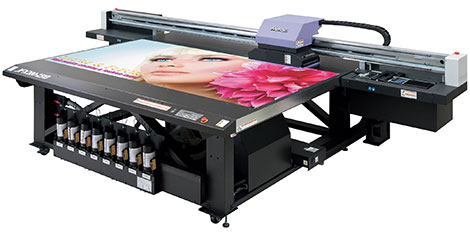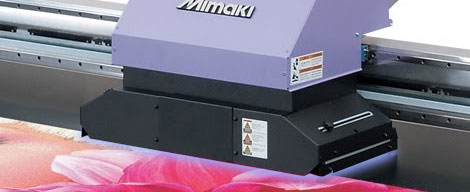
LFR's Marc Burnett offers his opinion on the Mimaki JFX200 and details why he believes it is a UV flatbed printer that businesses cannot afford to ignore.
At this year’s Sign & Digital UK exhibition there were four Mimaki JFX200 printers being demonstrated on four different booths; three of those booths belonged to resellers who would have had to significantly increase their booth floor-space costs in order to showcase the Mimaki flatbed. They’ll have made that investment with confidence that the increased cost of demonstrating the printer will have been offset by leads and indeed sales.
The point I’m making is that the Mimaki JFX200 is a printer that is rapidly becoming the de facto standard for any sign and display print business looking to make a move into flatbed UV printing, and the resellers know it – they are all excited at the new business that they are winning with this latest Mimaki flatbed.
Mimaki is also rightly proud of the sales numbers across Europe, the Middle East and Africa. The company reports a steady growth in sales of the JFX200 UV flatbed since its launch date.
Currently Mimaki is selling more than 40 of its JFX200 printers every month, and these impressive sales numbers are still on the increase. Indeed the Mimaki JFX200 is, according to Mimaki Japan, now the world’s top selling UV flatbed printer. Undoubtedly it has to date been one of the most successful product launches in Mimaki history.
So what’s the fuss all about? Why is this flatbed printer creating such a buzz, and why is it being installed in these record-breaking and market-defining numbers?
First off, let’s give you a quick snapshot view of its capabilities: The Mimaki JFX200 UV LED flatbed printer is able to print 8' x 4' rigid boards up to a thickness of 50mm, at up to 1200 dots per inch with quality further augmented through variable dot printing down to a 4 picolitre drop size - and it does all this at a speed of up to 25 square metres an hour.
As well as the primary CMYK ink set, you’ll find zero-cost options for printing with white ink, clear ink (with a primer coming soon) and now a choice of LH100 hard inks, LUS150 flexible inks and most recently LUS200 fully flexible inks for thermo forming type applications.
The net result is a high quality, fast and versatile flatbed UV printer that performs well beyond its price point.
Here’s a more detailed look at why we think this outstanding printer should be on your shortlist, broken down for you in 3 key areas:
1. Capital Cost:
Today, if you buy a Mimaki JFX200 flatbed UV printer, you’ll get one for £59,995. That’s an incredible price, for a number of reasons.
Firstly this price falls way below the significant psychological barrier that exists when purchasing a UV flatbed – so far below it in fact, that the mind-set of the buyer is changed from thinking of it as an investment comparable to ‘buying a small house’ to instead comparing it to ‘buying a nice car’. That’s a big shift in the purchasing thought process.
Do you think that theoretical glass ceiling of product pricing doesn’t matter? I can assure you it does. And the veritable queue of buyers lining up to buy this affordable flatbed print powerhouse is all the proof you need. In pricing this printer, Mimaki has effectively created a whole new price point, a whole new customer base, and sales success has subsequently followed.
This price also sits the Mimaki in the midst of competing printers that simply, well, cannot actually compete that well.
To get like for like performance, comparable build quality, and the ability to print 8’ x 4’ boards rapidly and at high quality, you’d have to spend significantly more on any alternative.
To get like for like pricing, you’d need to be looking at a brand-name printer that has been throttled back in terms of its features, functionality and productivity – or you could of course take a gamble and try your luck with a cheap flatbed printer of questionable origin, more than questionable pedigree and the distinct possibility of all but non-existent after-sales support.
2. LED Lamps:
We’ve previously written a feature on the benefits of LED UV lamps - read it here to save us going over the same ground again – and the benefits, for the jobbing printer certainly, are significant.
In a nutshell you’ll get significantly longer lamp life - by a factor of multiples - when compared to mercury lamps.
With LED lamps you’ll get no realistic heat produced; LED lamps are cool in more than one sense and what this means in real terms is an ability to print to more substrates, including thin and sensitive materials.
You also benefit from Mimaki variable lamp intensity - beyond the simple On or Off of most mercury lamps - again meaning better tuning of cure performance to the specific substrate and ink partnership.
When talking about LED vs Mercury, warranty is also a factor, and a potential cost. A typical mercury lamp will have a lifespan of about 500 to 1000 hours, so if you’re busily printing you’ll be changing lamps every 3 to 6 months, or you’ll inevitably suffer from the inherent degradation of curing performance that comes as standard with a mercury lamp equipped printer.
The expected life of the Mimaki LED lamps is actually well in excess of 10,000 hours, with Mimaki reporting a potential upper operational ceiling of as much as 20,000 hours. That said, the actual warranty on the lamps is for 5,000 hours of printing – plenty enough to last your average sign & display print shop a good number of years.

3. Warranty and Credible UK based Support
Beyond the lamp issue, here in the UK you’ll be buying a Mimaki JFX200 with a full 2 year warranty as standard. That’s 2 years for you to recover your up-front capital costs before you even begin to consider the cost of your printers maintenance and upkeep. Indeed if your £59,995 Mimaki JFX200 has not paid for itself within that warranty period, well frankly, you’re probably in the wrong game.
From the end of year 2, you’ll be looking at an annual cost of just £4,995 for a warranty that also covers the printheads and again the lamps, even when the lamps have gone beyond their own 5,000 hour warranty.
The warranty is provided here in the UK by exclusive Mimaki UK & Ireland distributor Hybrid – with service provided by its own in-house Mimaki-trained engineering team.
Yeah but…
Of course there are counter arguments. One of them might be that bigger, faster and more expensive UV flatbed printers have lower ink costs. Personally, I think that’s perhaps an argument best saved for the time when you actually need a bigger, faster and more expensive UV flatbed, perhaps to meet the demand for higher print volumes from business that your Mimaki JFX200 might have won for you.
The bottom line?
In my opinion, today, right here right now, at this price point you simply cannot make a flatbed UV printer purchase without first taking a very close look at the Mimaki JFX200.
Think I’ve got it wrong? I’m here to be proven wrong, and I’m more than happy to listen to any counter-arguments, and indeed give you the platform of LFR to share your thinking. Get in touch.




